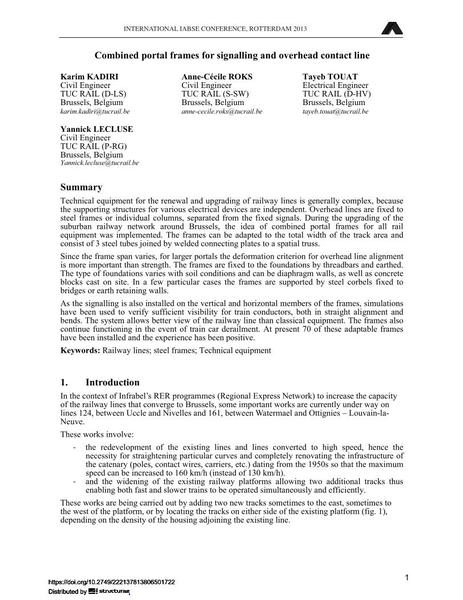Combined portal frames for signalling and overhead contact line

|
|
|||||||||||
Bibliografische Angaben
| Autor(en): |
Karim Kadiri
Anne-Cécile Roks Tayeb Touat Yannick Lecluse |
||||
|---|---|---|---|---|---|
| Medium: | Tagungsbeitrag | ||||
| Sprache(n): | Englisch | ||||
| Tagung: | IABSE Conference: Assessment, Upgrading and Refurbishment of Infrastructures, Rotterdam, The Netherlands, 6-8 May 2013 | ||||
| Veröffentlicht in: | IABSE Conference, Rotterdam, May 2013 | ||||
|
|||||
| Seite(n): | 378-379 | ||||
| Anzahl der Seiten (im PDF): | 6 | ||||
| Jahr: | 2013 | ||||
| DOI: | 10.2749/222137813806501722 | ||||
| Abstrakt: |
Technical equipment for the renewal and upgrading of railway lines is generally complex, because the supporting structures for various electrical devices are independent. Overhead lines are fixed to steel frames or individual columns, separated from the fixed signals. During the upgrading of the suburban railway network around Brussels, the idea of combined portal frames for all rail equipment was implemented. The frames can be adapted to the total width of the track area and consist of 3 steel tubes joined by welded connecting plates to a spatial truss. Since the frame span varies, for larger portals the deformation criterion for overhead line alignment is more important than strength. The frames are fixed to the foundations by threadbars and earthed. The type of foundations varies with soil conditions and can be diaphragm walls, as well as concrete blocks cast on site. In a few particular cases the frames are supported by steel corbels fixed to bridges or earth retaining walls. As the signalling is also installed on the vertical and horizontal members of the frames, simulations have been used to verify sufficient visibility for train conductors, both in straight alignment and bends. The system allows better view of the railway line than classical equipment. The frames also continue functioning in the event of train car derailment. At present 70 of these adaptable frames have been installed and the experience has been positive. |
||||
| Stichwörter: |
Bahnstrecken technische Ausrüstung
|
||||
